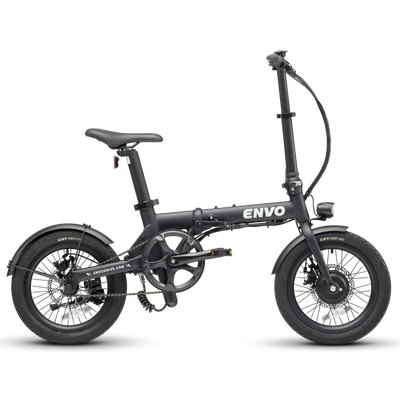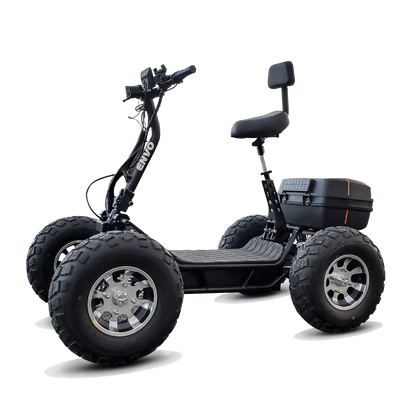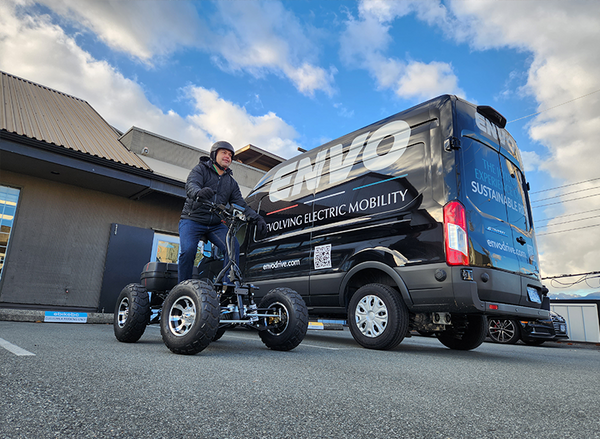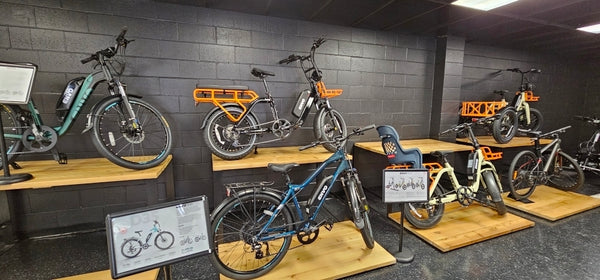Are Smaller or Micro EVs Relevant in North America:
There are several areas where smaller or Micro EVs come to the picture;
Urban Mobility:
Smaller EVs are well-suited for urban environments where shorter commutes and limited parking space are common. They can easily maneuver through congested city streets and fit into tight parking spaces.1
Non-Urban Micro-Mobility
Smaller electric vehicles (EVs) can also find relevance and popularity in non-urban and niche utility use cases in North America. Here are some scenarios where smaller EVs can be advantageous:
Rural and Suburban Commuting: In rural and suburban areas, where daily commutes tend to be shorter than in major cities, smaller EVs can offer a cost-effective and environmentally friendly mode of transportation.
Agriculture and Farming: Smaller EVs, such as compact electric tractors or utility vehicles, can be used in agriculture for tasks like crop maintenance, hauling, and spraying. They are quieter and produce no emissions, which can be beneficial on farms.
Golf Courses: Electric golf carts are common on golf courses due to their quiet operation and low environmental impact. They can also be used in other recreational settings like resorts, parks, and campgrounds.
Campus and Industrial Facilities: Smaller EVs are practical for transportation within large industrial complexes, manufacturing plants, and university campuses. They can be used for personnel transport, maintenance, and security patrols.
Postal and Mail Delivery: Electric mail delivery vehicles are well-suited for short, stop-and-start routes typically seen in mail delivery services. They offer cost savings and reduce noise pollution in residential areas.
Last-Mile Delivery: Smaller EVs, including electric cargo bikes and compact vans, can be used for last-mile delivery in both urban and rural areas. They are efficient for delivering packages to homes and businesses.
Tourism and Hospitality: Electric shuttles, tuk-tuks, and small tour buses can provide eco-friendly transportation options for tourists in scenic and historic areas.
Recreational Vehicles (RVs): Smaller electric RVs and campers can cater to eco-conscious travelers who want a more sustainable and quieter way to explore nature and camping sites.
Construction and Maintenance: Small electric utility trucks and vehicles can be used in construction sites and maintenance activities within industrial facilities. They produce no emissions and are often quieter than traditional vehicles.
Specialized Applications: Smaller EVs can be adapted for niche applications, such as mobile medical clinics, food trucks, and mobile workshops, offering unique solutions to specific needs.
Security and Emergency Services: Smaller EVs can be widely used for patrolling, search and rescue, urban security and even military services were silence and agile actions are required.
How do the North American micro EV market requirements differ from Europe, and could these disparities lead to the emergence of new types or classes of small EVs?
Micro electric vehicles (MEVs), including micro e-cars, cargo ebikes, e-scooters and e-bicycles, have been gaining extreme popularity in the European countries due to environmental concerns, urban mobility initiatives, infrastructure development, last-mile connectivity needs, and relevant regulations, with cities actively promoting their use. The North American micro EV market however, has requirements different from Europe in several ways due to variations in lifestyle, use cases, geography, population distribution, and cultural differences.
Cultural diversity and the versatile nature of micro-mobility and micro-utility requirements in North America play a significant role in shaping the demand for innovative transportation solutions. To illustrate this, consider the variety of vehicles that can be found in a typical North American family house garage:
-
Passenger Cars (Sedans, SUVs, Minivans)
-
Bicycles
-
Motorcycles
-
Lawnmowers and gardening tools
-
All-Terrain Vehicles (ATVs)
-
Scooters (Motorized and Non-Motorized)
-
Electric and Manual Wheelchairs
-
Golf Carts
-
Snowmobiles and sleds
-
Dirt Bikes
-
Tricycles (Adult and Child)
-
Electric Scooters (for commuting)
-
Utility Vehicles (e.g., for yard work)
-
Trailer attachments for transporting equipment and gear
-
Jet skis
-
Surfboards, paddle-boards
-
boats
-
kayak canoes
-
Child Strollers and Wagons
-
RVs or camper trailers
-
Motor-homes
-
Vintage trucks or convertible cars
Depending on the location a property style, sometimes even construction or farming vehicles are common in a family house garage.
In this context, micro EVs in North America must be adaptable and diverse to meet the multifaceted needs of a culturally varied population. Whether for urban commuting, off-road adventures, family outings, or utility tasks, these vehicles should offer the versatility and convenience akin to the varied contents found within a North American family house garage.
These disparities could indeed lead to the emergence of new types or classes of small EVs tailored to the North American market. Here's an exploration of these differences and their potential implications:
1. Lifestyle and Use Cases:
North America: North America often features more suburban and car-dependent lifestyles. Commutes tend to be longer, and people often require vehicles that can cover greater distances comfortably. Additionally, there's a strong car culture with a preference for larger vehicles, such as trucks and SUVs, for various activities, including recreational outings and long-distance travel.
Europe: European cities are typically more compact, and urban dwellers rely heavily on public transportation. Shorter commutes, efficient public transit, and a preference for smaller vehicles that can navigate narrow streets and park easily are characteristic of European urban living.
Implication: In North America, micro EVs may need to focus on extended range capabilities to accommodate longer commutes and suburban lifestyles. They might also need to offer versatility for outdoor activities and recreational use.
2. Geography:
North America: North America is known for its vast and varied geography, including expansive urban areas, deserts, mountains, and rural regions. Geographic diversity can pose unique challenges for micro EVs, particularly related to terrain and climate.
Europe: European countries tend to have more homogeneous and compact geography, with a milder climate overall. This facilitates consistent driving conditions and charging infrastructure development.
Implication: Micro EVs in North America may need to consider factors like all-wheel drive options, improved heating and cooling systems, and adaptations for various terrains to address regional variations.
3. Population Distribution:
North America: The population in North America is spread across large areas, resulting in lower population densities in many regions. This can influence the need for more versatile micro EVs that can handle longer distances.
Europe: European countries generally have higher population densities, particularly in urban areas. This often favors smaller, compact EVs designed for city living.
Implication: Micro EVs in North America might need to consider factors like range and charging infrastructure to accommodate more dispersed populations and suburban living.
4. Cultural Differences:
North America: North American car culture often celebrates larger vehicles, which can impact the adoption of smaller EVs. Cultural preferences for spacious interiors, off-road capabilities, and long-range travel may influence the design of micro EVs.
Europe: European car culture, on the other hand, has a long history of compact, fuel-efficient vehicles, making smaller EVs a natural fit for urban environments.
Implication: Micro EVs in North America may need to address cultural preferences and offer features that resonate with consumers accustomed to larger, more versatile vehicles.
What would potentially accelerate acceptance of Micro EV's by people in near future?
Below are a few reasons that boost the adoption of micro-EVs as transportation alternatives in North American communities.
Environmental Concerns: As concerns about climate change and air quality grow, there's a growing interest in reducing emissions in cities. Smaller EVs offer an eco-friendly alternative for urban transportation.
Budget-Friendly: Smaller EVs tend to be more affordable than larger ones, both in terms of upfront costs and ongoing maintenance. This makes them attractive to budget-conscious consumers.
Commuting: Many people in North America have relatively short commutes to work or school. Smaller EVs with modest ranges are sufficient for these daily trips.
Zoning Regulations: Some cities are implementing zoning regulations that restrict the size of vehicles in certain areas. Smaller EVs can comply with such restrictions.
Evolution through Generational Shift: Embracing Micro EVs for Sustainable Urban Mobility:
Indeed, the evolving environmental values of younger generations can have a significant impact on the popularity of smaller electric vehicles (EVs) in North America. Here's how these changing values contribute to the push for smaller EVs:
Environmental Concern: Younger generations are more environmentally conscious and place a strong emphasis on reducing carbon emissions and combating climate change. Smaller EVs tend to have a smaller carbon footprint due to their size and efficiency, making them a natural choice for eco-conscious consumers.
Preference for Sustainable Transportation: Younger individuals often prioritize sustainable transportation options. Smaller EVs are generally more energy-efficient and produce fewer emissions compared to larger gasoline-powered vehicles, aligning with the sustainability values of younger consumers.
Urban Living and Short Commutes: Many younger adults are choosing to live in urban environments with shorter commutes. Smaller EVs are well-suited for city driving and shorter trips, making them a practical choice for those who live and work in urban areas.
Desire for Alternative Mobility Solutions: Younger generations are open to exploring alternative mobility solutions beyond traditional car ownership. Smaller EVs, particularly in shared mobility services like car-sharing and ride-hailing, can provide cost-effective and eco-friendly transportation options.
Support for Technological Advancements: Younger consumers tend to embrace technology and innovation. As electric vehicle technology continues to improve, smaller EVs are likely to benefit from advancements in battery range, charging infrastructure, and features, making them more appealing.
Advocacy and Influence: Younger generations are active advocates for environmental causes. They can influence buying decisions within their peer groups and communities, encouraging the adoption of smaller EVs as a sustainable choice.
Policy and Regulation: The environmental values of younger generations can influence political discourse and policy development. Governments may implement incentives, subsidies, and regulations that promote the adoption of EVs, including smaller models.
Market Demand: As younger consumers enter the market for new vehicles, their preference for smaller EVs can drive manufacturers to produce more models and invest in research and development for this segment.
Cultural Shift: A cultural shift toward valuing efficiency, sustainability, and eco-friendliness in transportation can further promote the acceptance and popularity of smaller EVs.
What Actions Make Smaller EVs More Popular in North America:
Affordability: To gain popularity, smaller EVs must remain competitively priced. Incentives, subsidies, and tax breaks can help make them more affordable for consumers.
Improved Range: Addressing the "range anxiety" issue by enhancing the range of smaller EVs can make them more practical for consumers, especially for those who occasionally need to drive longer distances.
Charging Infrastructure: Expanding the EV charging infrastructure, particularly in urban areas, will make it more convenient for users of smaller EVs to find charging stations.
Marketing and Education: Effective marketing campaigns and educational efforts can help consumers understand the benefits of smaller EVs for urban and short-distance travel.
Fleet Adoption: Encouraging businesses and organizations with fleets to adopt smaller EVs can boost their visibility and popularity. Companies often set trends in vehicle adoption.
Collaboration with Ride-Sharing Services: Partnering with ride-sharing companies to introduce smaller EVs into their fleets can expose more people to the technology.
Government Policies: Supportive policies such as traffic regulations update, emissions regulations, zero-emission vehicle mandates, and incentives for EV adoption can drive the popularity of smaller EVs.
Technological Advancements: Versatility in design and configurations of small EVs or even mass-customization solutions will provide products that can address more and more people and use cases.
Consumer Preferences: As more consumers become environmentally conscious and prioritize efficiency and practicality over size, the demand for smaller EVs may naturally increase.
Vehicles and Batteries Recycling facilities: For a sustainable mindset to adopt and advocate a sustainable solution, there needs to be answers to all aspects of sustainability. Recycling of small EV's after service period is not an exception.
Resale Value: Ensuring that smaller EVs have a strong resale value can encourage more consumers to consider them as a viable option.
What roles do the governments, industry, and consumers play in promoting smaller EVs in North America?
In the pursuit of a more sustainable and eco-friendly future, the promotion of smaller electric vehicles (EVs) in North America has gained significant momentum. To drive this transformation, governments, industry stakeholders, and consumers each have pivotal roles to play. Here are the top 2 responsibilities of each party.
Government Initiatives:
-
Regulation: One of the primary roles of governments in promoting smaller EVs is to enact traffic regulations that create a conducive environment for these vehicles. This includes defining new vehicle categories, such as micro EVs, and ensuring that they meet safety and emissions standards. Governments can also establish rules that encourage the use of smaller EVs in urban areas, such as carpool lane access or reduced parking fees.
-
Education: Governments should engage in extensive public education campaigns to raise awareness about the benefits of smaller EVs. These campaigns can dispel myths, provide information about incentives, and emphasize the environmental and cost-saving advantages of these vehicles. Educating consumers about the differences between traditional cars and smaller EVs can help in making informed choices.
Industry Efforts:
-
Creation: The automotive industry plays a central role in creating smaller EV models that cater to a wide range of consumer preferences. Manufacturers must invest in research and development to improve battery technology, extend vehicle range, and enhance affordability. By diversifying their product portfolios to include smaller EVs, the industry meets varying customer needs.
-
Promotion: Effective marketing and promotion are essential to introduce smaller EVs to the market successfully. Manufacturers should highlight the advantages of these vehicles, such as reduced operating costs, lower environmental impact, and suitability for urban commuting. Promotional efforts can target both individual consumers and fleet operators, emphasizing the long-term benefits of smaller EV adoption.
Consumer Participation:
-
Education: Consumers should actively seek information about smaller EVs and their advantages. Online research, reviews, and test drives can help consumers gain a better understanding of how these vehicles can fit their lifestyle and save them money over time. Being well-informed is the first step in making an environmentally conscious choice.
-
Consideration: When making purchasing decisions, consumers should consider the practicality of smaller EVs for their daily needs, especially if their regular commute is within the vehicle's range. Smaller EVs are often ideal for urban dwellers and those with shorter daily travel distances.
Encouraging North American Governments and Municipalitues to Embrace Micro EVs for a Sustainable Future
In the ever-evolving landscape of electric vehicles (EVs), North America stands at a crossroads. While the adoption of traditional electric cars has been on the rise, there's a pressing need for governments to rethink vehicle definitions and street regulations to accommodate a new generation of compact, eco-friendly solutions: micro EVs.
Currently, North American streets primarily cater to what we commonly refer to as "small cars." However, a wealth of single-passenger, low-speed vehicles and micro-car concepts remains outside the legal framework for most regions in the continent. In contrast, Europe has already paved the way for such innovative mobility solutions by defining classifications like L6e and L7e, making these micro vehicles street-legal in many areas.
The absence of similar vehicle categories in most North American cities hinders the potential for these highly efficient and sustainable micro EVs to thrive. To bridge this gap, it's imperative that North American governments revisit and expand their definitions of street-legal vehicles.
One existing classification, LSV (Low-Speed Vehicle), presents an opportunity, but its origins in agricultural vehicles limit its comprehensiveness for today's and future urban transportation needs. These vehicles are more tailored for enclosed communities and golf courses, making them less suitable for widespread urban mobility.
To truly unlock the potential of micro EVs, North American governments should consider the following steps:
-
Defining New Vehicle Classes: Governments should actively work on introducing new vehicle classifications specifically tailored to micro EVs. These categories should encompass a wide range of single-passenger and low-speed electric vehicles designed for urban commuting, short trips, and specialized use cases.
-
Comprehensive Regulations: Street regulations need to be comprehensive, addressing not only safety but also environmental and efficiency standards. Well-crafted regulations can ensure that these micro EVs meet the highest standards for sustainability, safety, and performance.
-
Supporting Innovation: Governments should encourage innovation in micro EV technology, design, and manufacturing. Incentives and grants can be provided to companies and startups working on sustainable mobility solutions. They also can be the first to adopt Micro-EVs alternatives into their fleets.
-
Infrastructure Development: Accommodating micro EVs will require adjustments to urban infrastructure, including charging stations, parking facilities, and dedicated lanes. Investments in these areas are essential for the successful integration of micro EVs into North American cities.
-
Public Awareness: Governments can also play a role in raising public awareness about the benefits of micro EVs, such as reduced traffic congestion, lower emissions, and cost savings. Education campaigns can help foster acceptance and adoption.




































